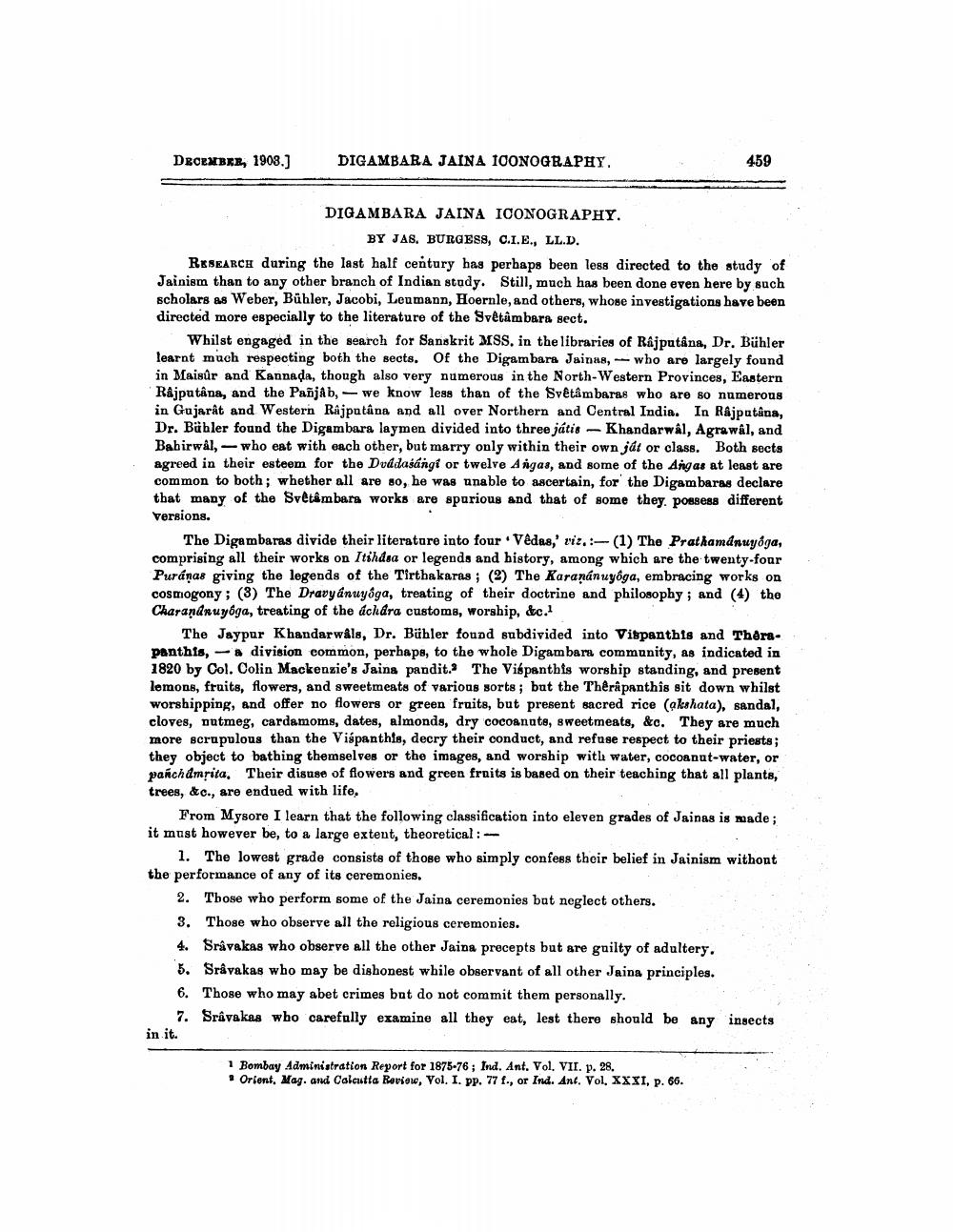________________
DECEMBER, 1908.]
DIGAMBARA JAINA 100NOGRAPHY.
459
DIGAMBARA JAINA ICONOGRAPHY. BY JAS. BURGESS, C.I.E., LL.D.
RESEARCH during the last half century has perhaps been less directed to the study of Jainism than to any other branch of Indian study. Still, much has been done even here by such scholars as Weber, Bühler, Jacobi, Leumann, Hoernle, and others, whose investigations have been directed more especially to the literature of the Svêtâmbara sect.
Whilst engaged in the search for Sanskrit MSS. in the libraries of Rajputâna, Dr. Bühler learnt much respecting both the sects. Of the Digambara Jainas, who are largely found in Maisûr and Kannada, though also very numerous in the North-Western Provinces, Eastern Rajputâna, and the Pañjab, we know less than of the Svêtâmbaras who are so numerous in Gujarat and Western Rajputâna and all over Northern and Central India. In Rajputana, Dr. Bühler found the Digambara laymen divided into three játis Khandarwâl, Agrawal, and Bahirwal, who eat with each other, but marry only within their own ját or class. Both sects agreed in their esteem for the Dvddasangi or twelve Angas, and some of the Angas at least are common to both; whether all are so, he was unable to ascertain, for the Digambaras declare that many of the Svêtêmbara works are spurious and that of some they. possess different versions.
The Digambaras divide their literature into four Vêdas, viz.:- (1) The Prathamánuyoga, comprising all their works on Itihdsa or legends and history, among which are the twenty-four Puranas giving the legends of the Tirthakaras; (2) The Karanánuyoga, embracing works on cosmogony; (3) The Dravyanuyoga, treating of their doctrine and philosophy; and (4) the Charananuyoga, treating of the áchára customs, worship, &c.1
The Jaypur Khandarwâls, Dr. Bühler found subdivided into Vispanthis and Therapanthis, -a division common, perhaps, to the whole Digambara community, as indicated in 1820 by Col. Colin Mackenzie's Jaina pandit. The Vispanthis worship standing, and present lemons, fruits, flowers, and sweetmeats of various sorts; but the Thêrâpanthis sit down whilst worshipping, and offer no flowers or green fruits, but present sacred rice (akshata), sandal, cloves, nutmeg, cardamoms, dates, almonds, dry cocoanuts, sweetmeats, &c. They are much more scrupulous than the Vispanthis, decry their conduct, and refuse respect to their priests; they object to bathing themselves or the images, and worship with water, cocoanut-water, or panchamrita. Their disuse of flowers and green fruits is based on their teaching that all plants, trees, &c., are endued with life,
From Mysore I learn that the following classification into eleven grades of Jainas is made; it must however be, to a large extent, theoretical:
1. The lowest grade consists of those who simply confess their belief in Jainism without the performance of any of its ceremonies.
2. Those who perform some of the Jaina ceremonies but neglect others.
3. Those who observe all the religious ceremonies.
4. Sravakas who observe all the other Jaina precepts but are guilty of adultery.
5. Sravakas who may be dishonest while observant of all other Jaina principles.
6. Those who may abet crimes but do not commit them personally.
7. Srâvakas who carefully examine all they eat, lest there should be any insects
in it.
1 Bombay Administration Report for 1875-76; Ind. Ant. Vol. VII. p. 28.
Orient, Mag. and Calcutta Review, Vol. I. pp. 77 f., or Ind. Ant. Vol. XXXI, p. 66.




